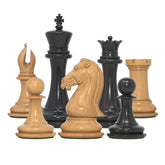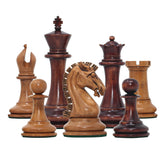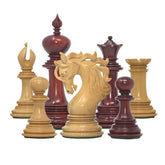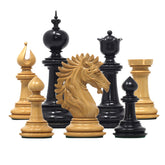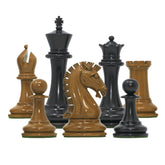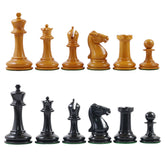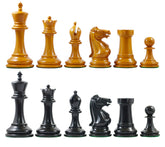7 TYPES OF DRAWS IN CHESS THAT YOU SHOULD KNOW
As you know, not every chess game ends with a winner or a loser. A very important part of the game of chess: The Draw. There are many different ways in which a chess game might end in a draw.

In chess, a draw occurs when neither player can achieve a checkmate or when both players agree to a draw. Draws can happen due to various reasons, including stalemate, threefold repetition, insufficient material, perpetual check, the 50-move rule, and mutual agreement. Let's read about these seven types of draws in chess.
Stalemate
A stalemate occurs when a player, although not in check, has no legal moves to make. This situation leads to a draw because the player is not in checkmate, but also cannot continue the game. It can happen when a player's pieces are blocked or when a player's king is confined to a small area with no legal moves. Stalemates are often seen as a defensive resource for the player in a losing position, providing an opportunity to salvage a draw.
Threefold Repetition
Threefold repetition refers to a situation where the same position occurs on the chessboard three times, with the same player to move and the same possible moves available. The position doesn't have to occur consecutively but can happen at any point during the game. If a player claims a draw by threefold repetition, the arbiter or opponent must confirm the claim. This rule encourages players to seek alternative moves and prevents a game from going on indefinitely.
Insufficient Material
If the remaining pieces on the board are not sufficient to checkmate the opponent, the game is declared a draw due to insufficient material. This occurs when both players have limited pieces left, such as a king against a king or a king against a king and a bishop or knight. Since these combinations alone cannot force a checkmate, the game is considered a draw. However, if additional pieces are present, such as pawns, it is still possible to achieve a checkmate.
Perpetual Check
A perpetual check occurs when one player repeatedly checks the opponent's king, forcing a repetition of moves. If the same position repeats three times with the same player to move, a draw can be claimed by the player giving the perpetual checks. Perpetual check often happens when one player has a strong attacking position but cannot find a decisive checkmate. The repetition of checks creates a draw by forcing a perpetual stalemate.
The 50-Move Rule

Buy Wooden Chess Sets and Pieces — www.stauntoncastle.com
The 50-move rule states that if there have been no captures or pawn moves in the last 50 moves by both players, a player can claim a draw. This rule prevents excessively long games without progress and incentivizes players to strive for decisive results. The 50-move count includes moves by both players, so if a player is close to the 50-move mark, they need to ensure they make progress in the game to avoid a draw.
Draw by Agreement
A draw by agreement, also known as a draw by mutual consent, is a type of draw in chess where both players agree to end the game with a tie result. This occurs when both players believe that the position on the board does not offer realistic winning chances for either side. Draw by agreement is a common occurrence in high-level chess tournaments where players are well-versed in the theory and strategy of the game.
Agreeing to a draw allows players to conserve energy and focus on future games, particularly in situations where prolonging the game would not significantly alter the outcome. It can also be a tactical decision, as players may assess that a draw is a favorable result based on their tournament standing or the complexity of the position.
Draw by agreement showcases the sportsmanship and respect between players, as it acknowledges the equal skill and effort put forth by both sides. While some may argue that draw agreements can lead to fewer decisive results, they are a recognized and accepted part of the game, providing an opportunity for players to secure half a point without further contesting the position.
Mutual Agreement
Players can agree to a draw at any point during the game if they both feel that the position is equal and neither player can achieve a checkmate. This is often seen in high-level tournaments when players have thoroughly analyzed the position and see no realistic chances of victory. Mutual agreements to a draw are accepted, and the game ends without a winner.
It's important to note that these types of draws are considered legitimate outcomes of a chess game. Draws are a significant part of chess strategy and can provide opportunities for players to save or secure half a point. They also demonstrate the complexity and depth of the game, as players navigate through intricate positions where neither side can claim victory.
Important Efforts to Reform Draw Rules

Buy Wooden Chess Sets and Pieces — www.stauntoncastle.com
Efforts to reform draw rules have gained significant attention and traction in recent years, aiming to address concerns about the fairness and competitiveness of various activities and competitions. Whether it be sports events, art contests, or even random prize draws, the rules governing how winners are selected have come under scrutiny.
One key aspect of draw rule reform is the emphasis on transparency. In the past, there have been instances where the draw process lacked transparency, leading to suspicions of favoritism or manipulation. To counteract this, organizations have implemented measures such as live-streaming the draw process, involving independent auditors, and publishing detailed reports on the selection methodology. By promoting transparency, participants and the general public can have confidence in the fairness of the draw.
Another important aspect of draw rule reform is ensuring equal opportunity for all participants. This includes measures to prevent bias or discrimination based on factors such as age, gender, or nationality. Some organizations have introduced diversity quotas or specific eligibility criteria to ensure a level playing field for everyone involved. Moreover, efforts have been made to eliminate any loopholes or ambiguities that could be exploited to gain an unfair advantage.
Furthermore, technology has played a significant role in draw rule reform. The use of randomization algorithms and sophisticated software has enhanced the integrity and efficiency of the selection process. Automated systems have reduced the risk of human error or manipulation, ensuring a more transparent and unbiased outcome.
Overall, the efforts to reform draw rules reflect a broader societal demand for fairness and inclusivity. By promoting transparency, equal opportunity, and leveraging technology, organizations, and institutions are taking significant steps to restore confidence in the draw process. These reforms not only benefit participants but also contribute to the overall integrity and credibility of the activities and competitions in question.
For more interesting articles visit www.stauntoncastle.com
Buy Wooden Chess Sets and Pieces — www.stauntoncastle.com


